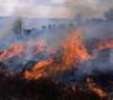
Fire Research on Smoke Management, Better Forecasts Being Funded
The Joint Fire Science Program, a partnership of six federal wildland management and research agencies that addresses problems associated with managing wildland fuels, fires, and fire-impacted ecosystems, will award up to $10 million for research on these and several more topics, with proposals due by Nov. 20.
The Joint Fire Science Program, a partnership of six federal wildland management and research agencies that addresses problems associated with managing wildland fuels, fires, and fire-impacted ecosystems, is accepting proposals until Nov. 20 for as many as 30 research projects, including projects to improve the accuracy of fire weather forecasts and issues surrounding the public’s perceptions of smoke management in wildfires. Total funding available for these projects is $8-10 million, according to the project announcement issued Sept. 25.
The program's partner agencies are the U.S. Forest Service and five bureaus in the U.S. Department of the Interior: Bureau of Indian Affairs, Bureau of Land Management, National Park Service, Fish and Wildlife Service, and the Geological Survey.
Fire weather forecasts are usually derived from the National Digital Forecast Database, which is based on Real-Time Mesoscale Analysis by the National Weather Service. That analysis incorporates observations from a various observation networks into a 3D model of the atmosphere and land surface and subsequently refined by local fire weather forecasters; errors in each step of this process are propagated through the chain of observations and models that result in a fire weather forecast, according to the announcement, which says proposals for this portion should address these questions:
- How well do fire weather forecasts perform as compared to observed conditions? How can the impact of observation or model errors be quantified to provide measures of forecast confidence for the user?
- What is the impact of different measurement standards and errors in observation networks on fire weather forecasts, and how does this affect accuracy assessments?
- What is the impact of processing techniques that downscale model information, and how do they affect forecast accuracy?
- Are there improved techniques to better represent the influences of complex terrain?
- What is the impact of boundary conditions on forecast accuracy? Can enhanced observations or improved modeling techniques improve boundary representation?
The smoke management project(s) will study how the length of people's exposure to smoke, or the density and composition of the smoke, affects their tolerance for it. "Citizen and community tolerance for smoke affects decisions for both planned and unplanned fires. The location, timing, and specific parameters for prescribed fires may all be influenced by public perceptions. Priorities for initial attack, incident response decisions, and the extent of mop-up activities may also be influenced by public perceptions of smoke," the announcement states. "While health and safety (i.e., visibility) are the primary reasons for public concern over smoke, less is known about the factors shaping public tolerance of smoke. Better information regarding public tolerance for smoke will help managers make better decisions about fire and fuel management activities."
Proposals must address at least one of the following questions:
- How does the length of time people are exposed to smoke, or the density or concentration of smoke parameters, e.g., PM2.5, affect their tolerance of smoke?
- How does the source of the smoke, e.g., planned versus unplanned fire, or the purpose of the smoke, e.g., managing fuels for forest health versus treating residual fuels from a timber harvest activity, affect people's tolerance of smoke?
- How does the degree of active management on a fire, e.g., intense suppression versus monitoring, affect people's tolerance of smoke?
- How effective are programs to manage the impacts of smoke, e.g., various notification programs, and how can they be more effective?
- Do higher levels of community preparedness for fire, e.g., active partnerships engaged with local land managers or well-developed preparedness plans, foster more or less tolerance of smoke?
Proposals are due by 5 pm MST Nov. 20 using the electronic submission process provided at www.firescience.gov.